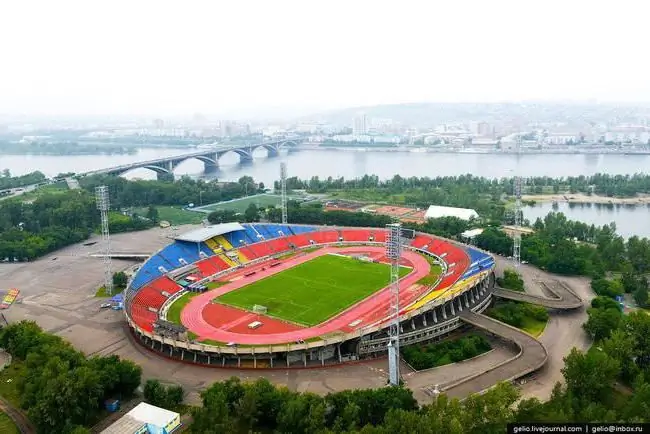- Author Harold Hamphrey [email protected].
- Public 2023-12-17 10:06.
- Last modified 2025-01-24 11:10.
The mountainous country of the Pamirs has been attracting adventurers for a long time. Once it was the highest mountain region in the USSR. Many people dreamed of conquering the Pamirs… No wonder it got its name - "the roof of the world". There are many famous seven-thousanders of the planet here. And although the Pamir mountains are not as high as, for example, the Himalayas and the Karakorum, some of its peaks have remained unconquered.
Pamir location
The Pamirs are mountains, or rather, it is a large mountainous country located in the southern part of Central Asia. The territory of the Pamirs is located within the borders of four states: Tajikistan (the main part), Afghanistan, China and India. The Pamir Highlands formed at the junction of the spurs of such mountain systems as the Hindu Kush, Kunlun, Karakoram and Tien Shan. They occupy an area of sixty thousand square kilometers of the Pamir Mountains. The photo below shows how vast this mountainous country is.

There is no common opinion about the origin of the name of the mountainous country. Among the transcripts there are such as "roofMithras" (the sun god in Mithraism), as well as the "roof of the world", "foot of death" and even "bird's paw".
The highest mountains of the Pamirs
The highest mountains of the Pamirs reach almost eight thousandth height. Rising above all the peaks of this mountainous country is the peak of Kongur. It is located in China, and its height is 7.72 km. 200 meters below the peak of Ismail Samani - 7.5 km, which used to be called Communism Peak in Soviet times, and before that - even Stalin Peak. The Pamirs, whose mountains have Russian names, were part of the Soviet Union until the 1990s.

Peak Abu Ali ibn Sina (in the Russian version - Avicenna Peak), named after a medieval scientist and doctor, 7.13 km high, also changed its name twice. In the period before perestroika, it was called Lenin Peak, and initially Kaufman Peak (end of the 19th century) was named by the discoverers.
Also widely known is Korzhenevskaya Peak (height 7.1 km), named by a Russian scientist in honor of his beloved wife.
Features of the Pamirs
Pamir - mountains, which are an uneven quadrangle with raised edges. The area is rich in deposits of gold, coal, mica, rock crystal, lapis lazuli.
Long, harsh winters (at an altitude of 3.6 km, the average January temperature is 18 degrees Celsius, and the cold season lasts from October to April, including the extreme months), punctuated by short and cool summers (average temperature the hottest month - July - is only about 14 degrees Celsius). The humidity regime varies greatly inwide range, depending on the area, from 60 to 1100 millimeters of precipitation per year.

However, the unusually harsh climate is accompanied by a fairly diverse composition of the fauna. Especially memorable animals are argali - large mountain sheep, one of whose horns can reach thirty kilograms of weight. As well as shaggy yaks and a handsome snow leopard. In addition to them, several species of goats (kiyki, markhor), long-tailed marmots, urmal sheep, foxes and Tibetan wolves live at different heights.
In the highlands of the Pamirs, birds such as the finches, big lentils, desert bullfinches, snowcocks live. And ducks, Indian geese, golden eagles, white-tailed eagles nest near water bodies.
Among the ichthyological diversity, one can especially note such endemic fish as naked osman and marinka (the latter belongs to the category of poisonous).
History of conquests
The history of the systematic study of the mountainous country began in 1928, when the Soviet expedition to the Pamirs took place. In its course, it was possible to open the huge Fedchenko Glacier, conquer Lenin Peak and make a number of important measurements.
In 1933, Soviet climbers succumbed to the peak of Communism (the highest in the territory of the former USSR), and in the 50s of the twentieth century, the peaks of Korzhenevskaya, Revolution, Muztag-ata (7, 55 kilometers) and Konturtyube (7, 6 kilometers). The highest peak of the Pamirs was reached in 1981 by an English expedition led by Bonengton.
Lakes of the Pamir Highlands. Kara-Kul
The largest lake in the mountainous country - Kara-Kul. The name of the lake (Black Lake) has several explanations. According to one of them, it is deserved by the dark shade of water during a strong wind. According to another version, the waters of the Black Lake suddenly rose, flooding the coastal village, and the people's grief from this terrible tragedy is encrypted in the name.

Rises above the Eastern Pamir lake. Mountains, where there are various large lakes. The deepest of them is Sarez (0.5 km deep), and the largest is Kara-Kul. At an altitude of 4000 m, a huge lake with an area of 380 square kilometers and a depth of up to 240 meters is almost lifeless. Since the lake has no runoff, its waters are very s alty, and since the slowly melting remains of an ancient glacier lie at the bottom, the water is also extremely cold.
Despite the almost complete absence of ordinary flora and fauna in the lake, folk rumor inhabits its waters with various mythical creatures. In particular, it is believed that dragons, a flying horse that kidnaps foals, and even mermaids live in its waters. However, the icy waters of the lake do not encourage tourists to swim, and the mermaids, apparently, have to go on a diet.






